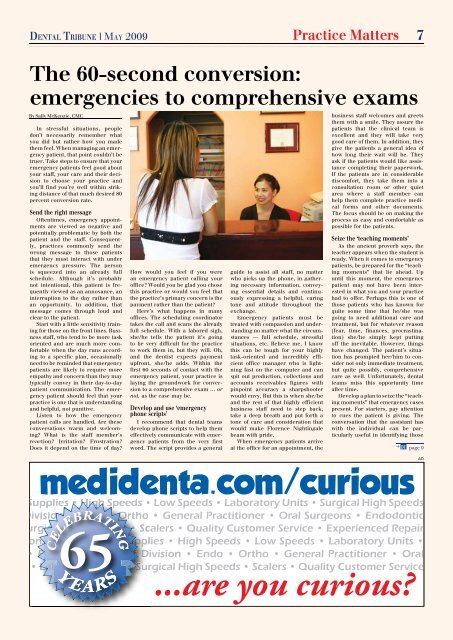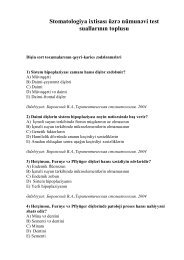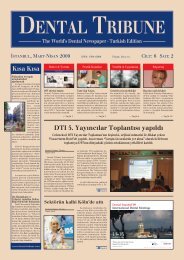DENTAL TRIBUNE
DENTAL TRIBUNE
DENTAL TRIBUNE
Create successful ePaper yourself
Turn your PDF publications into a flip-book with our unique Google optimized e-Paper software.
<strong>DENTAL</strong> <strong>TRIBUNE</strong> | MAY 2009 Practice Matters 7<br />
The 60-second conversion:<br />
emergencies to comprehensive exams<br />
By Sally McKenzie, CMC<br />
In stressful situations, people<br />
don’t necessarily remember what<br />
you did but rather how you made<br />
them feel. When managing an emergency<br />
patient, that point couldn’t be<br />
truer. Take steps to ensure that your<br />
emergency patients feel good about<br />
your staff, your care and their decision<br />
to choose your practice and<br />
you’ll find you’re well within striking<br />
distance of that much desired 80<br />
percent conversion rate.<br />
Send the right message<br />
Oftentimes, emergency appointments<br />
are viewed as negative and<br />
potentially problematic by both the<br />
patient and the staff. Consequently,<br />
practices commonly send the<br />
wrong message to those patients<br />
that they must interact with under<br />
emergency pressure. The person<br />
is squeezed into an already full<br />
schedule. Although it’s probably<br />
not intentional, this patient is frequently<br />
viewed as an annoyance, an<br />
interruption to the day rather than<br />
an opportunity. In addition, that<br />
message comes through loud and<br />
clear to the patient.<br />
Start with a little sensitivity training<br />
for those on the front lines. Business<br />
staff, who tend to be more task<br />
oriented and are much more comfortable<br />
when the day runs according<br />
to a specific plan, occasionally<br />
need to be reminded that emergency<br />
patients are likely to require more<br />
empathy and concern than they may<br />
typically convey in their day-to-day<br />
patient communication. The emergency<br />
patient should feel that your<br />
practice is one that is understanding<br />
and helpful, not punitive.<br />
Listen to how the emergency<br />
patient calls are handled. Are these<br />
conversations warm and welcoming?<br />
What is the staff member’s<br />
reaction? Irritation? Frustration?<br />
Does it depend on the time of day?<br />
How would you feel if you were<br />
an emergency patient calling your<br />
office? Would you be glad you chose<br />
this practice or would you feel that<br />
the practice’s primary concern is the<br />
payment rather than the patient?<br />
Here’s what happens in many<br />
offices. The scheduling coordinator<br />
takes the call and scans the already<br />
full schedule. With a labored sigh,<br />
she/he tells the patient it’s going<br />
to be very difficult for the practice<br />
to work them in, but they will. Oh,<br />
and the dentist expects payment<br />
upfront, she/he adds. Within the<br />
first 60 seconds of contact with the<br />
emergency patient, your practice is<br />
laying the groundwork for conversion<br />
to a comprehensive exam … or<br />
not, as the case may be.<br />
Develop and use ‘emergency<br />
phone scripts’<br />
I recommend that dental teams<br />
develop phone scripts to help them<br />
effectively communicate with emergency<br />
patients from the very first<br />
word. The script provides a general<br />
guide to assist all staff, no matter<br />
who picks up the phone, in gathering<br />
necessary information, conveying<br />
essential details and continuously<br />
expressing a helpful, caring<br />
tone and attitude throughout the<br />
exchange.<br />
Emergency patients must be<br />
treated with compassion and understanding<br />
no matter what the circumstances<br />
— full schedule, stressful<br />
situations, etc. Believe me, I know<br />
this can be tough for your highly<br />
task-oriented and incredibly efficient<br />
office manager who is lightning<br />
fast on the computer and can<br />
spit out production, collections and<br />
accounts receivables figures with<br />
pinpoint accuracy a sharpshooter<br />
would envy. But this is when she/he<br />
and the rest of that highly efficient<br />
business staff need to step back,<br />
take a deep breath and put forth a<br />
tone of care and consideration that<br />
would make Florence Nightingale<br />
beam with pride.<br />
When emergency patients arrive<br />
at the office for an appointment, the<br />
business staff welcomes and greets<br />
them with a smile. They assure the<br />
patients that the clinical team is<br />
excellent and they will take very<br />
good care of them. In addition, they<br />
give the patients a general idea of<br />
how long their wait will be. They<br />
ask if the patients would like assistance<br />
completing their paperwork.<br />
If the patients are in considerable<br />
discomfort, they take them into a<br />
consultation room or other quiet<br />
area where a staff member can<br />
help them complete practice medical<br />
forms and other documents.<br />
The focus should be on making the<br />
process as easy and comfortable as<br />
possible for the patients.<br />
Seize the ‘teaching moments’<br />
As the ancient proverb says, the<br />
teacher appears when the student is<br />
ready. When it comes to emergency<br />
patients, be prepared for the “teaching<br />
moments” that lie ahead. Up<br />
until this moment, the emergency<br />
patient may not have been interested<br />
in what you and your practice<br />
had to offer. Perhaps this is one of<br />
those patients who has known for<br />
quite some time that he/she was<br />
going to need additional care and<br />
treatment, but for whatever reason<br />
(fear, time, finances, procrastination)<br />
she/he simply kept putting<br />
off the inevitable. However, things<br />
have changed. The patient’s situation<br />
has prompted her/him to consider<br />
not only immediate treatment,<br />
but quite possibly, comprehensive<br />
care as well. Unfortunately, dental<br />
teams miss this opportunity time<br />
after time.<br />
Develop a plan to seize the “teaching<br />
moments” that emergency cases<br />
present. For starters, pay attention<br />
to cues the patient is giving. The<br />
conversation that the assistant has<br />
with the individual can be particularly<br />
useful in identifying those<br />
� DT page 9<br />
AD




